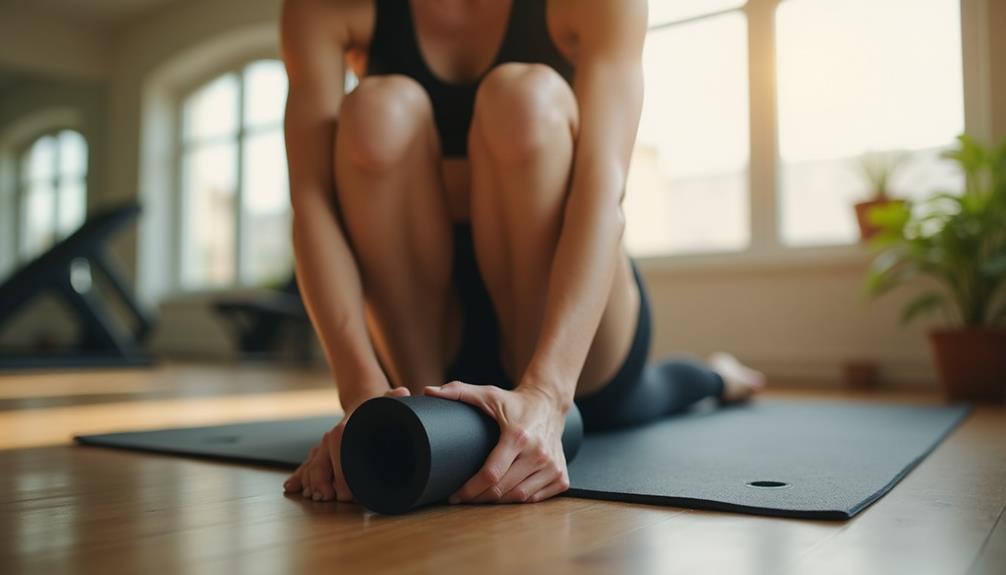To improve your post-workout muscle healing, focus on seven expert tips. First, hydrate properly by drinking 16-24 ounces of water within the first hour. Next, prioritize protein intake; aim for 20-30 grams within two hours, using high-quality sources. Incorporate active recovery like light cardio or stretching to keep blood flowing. Utilize foam rolling to alleviate muscle tightness and enhance flexibility. Get adequate sleep by establishing a routine and creating a restful environment. Manage stress through mindfulness to aid repair. Finally, consider supplements like protein powder and omega-3s to enhance recovery. Stay tuned for more detailed guidance on each tip.
Core Insights
- Hydrate immediately after exercise by drinking 16-24 ounces of water to aid nutrient transport for muscle recovery.
- Consume 20-30 grams of high-quality protein within 2 hours post-workout to support muscle healing.
- Incorporate active recovery activities like light cardio and stretching to enhance blood flow and reduce soreness.
- Utilize foam rolling techniques to alleviate muscle tightness and improve flexibility after workouts.
- Prioritize quality sleep and manage stress levels to optimize muscle repair and overall recovery.
Hydrate Properly

Hydration is vital for effective post-exercise muscle healing. After a workout, your body loses fluids through sweat, and replenishing these fluids is pivotal. Water helps transport nutrients to your muscles, aiding recovery. Aim to drink at least 16-24 ounces of water within the first hour after exercising. Coconut water brands can be an excellent alternative to plain water, offering natural electrolytes and potassium to support muscle function. These beverages are particularly beneficial for intense workouts or prolonged exercise sessions.
Keep in mind that your hydration needs may vary based on exercise intensity and duration. If you've had a particularly intense session, consider adding electrolytes to your drink. This can help restore balance in your body and support muscle function.
Listen to your body; if you're feeling thirsty, it's a sign you need to hydrate. Staying properly hydrated not only promotes quicker muscle recovery but also enhances your overall performance in future workouts.
Prioritize Protein Intake

To maximize muscle recovery after a workout, you should prioritize protein intake. Protein plays a pivotal role in repairing and building muscle tissue. Aim to consume a source of protein within 30 minutes to two hours post-exercise. This timing helps your muscles start the recovery process efficiently. While focusing on protein intake, it's important to be aware of privacy considerations when using fitness tracking apps or websites to monitor your nutrition.
Choose high-quality protein sources like lean meats, eggs, dairy, or plant-based options like beans and lentils. A good rule of thumb is to aim for 20-30 grams of protein after your workout.
Consider incorporating a protein shake if you find it challenging to meet this requirement through whole foods. Remember, consistently prioritizing protein in your post-workout routine will enhance your muscle healing and overall performance.
Incorporate Active Recovery

Incorporating active recovery into your routine can greatly enhance muscle healing after intense workouts. Active recovery keeps blood flowing to your muscles, which helps reduce soreness and speeds up recovery. Compression sleeves can also aid in recovery by providing targeted support and enhancing circulation. Here are three effective ways to include active recovery in your regimen:
- Light Cardio: Engage in low-intensity activities like walking, cycling, or swimming for 20-30 minutes. This keeps your heart rate elevated without straining your muscles.
- Stretching: Take time to stretch major muscle groups. Gentle stretching improves flexibility and reduces tightness, promoting healing.
- Mobility Exercises: Incorporate movements that focus on joint mobility. These exercises help maintain movement quality and prevent stiffness.
Utilize Foam Rolling

Active recovery techniques like light cardio, stretching, and mobility exercises lay a solid foundation for muscle healing, but don't overlook the benefits of foam rolling. This technique helps release muscle tightness, improve blood flow, and enhance flexibility. By using a foam roller, you can target specific muscle groups and alleviate soreness after your workouts.
| Foam Rolling Benefits | How to Use It | Frequency |
|---|---|---|
| Reduces muscle soreness | Roll slowly over tight areas | After workouts or daily |
| Improves blood flow | Apply pressure for 30 seconds | 2-3 times a week |
| Enhances flexibility | Focus on major muscle groups | Before and after workouts |
Incorporating foam rolling into your routine can greatly speed up recovery, allowing you to get back to your next workout efficiently.
Get Adequate Sleep

- Establish a Routine: Try to go to bed and wake up at the same time each day. Consistency helps regulate your body's internal clock.
- Create a Restful Environment: Keep your bedroom dark, cool, and quiet. Consider using blackout curtains and white noise machines if necessary.
- Limit Screen Time: Reduce exposure to screens an hour before bed. The blue light emitted can interfere with melatonin production, making it harder to fall asleep.
Manage Stress Levels

Managing stress levels is pivotal for effective muscle healing after workouts, as high stress can hinder recovery. When you're stressed, your body releases cortisol, which can impair your muscle repair processes. To keep stress in check, consider incorporating mindfulness practices like meditation or deep breathing exercises into your routine. These can help calm your mind and lower cortisol levels.
Additionally, engaging in light activities such as yoga or walking can also help reduce stress while promoting blood flow to your muscles. Make sure to identify stress triggers in your life and address them proactively. Creating a balanced post-workout regimen that includes relaxation techniques can enhance your recovery, helping you bounce back stronger for your next workout.
Consider Supplements

- Protein Powder: It provides essential amino acids that support muscle repair and growth. Aim for a high-quality source, like whey or plant-based proteins.
- Omega-3 Fatty Acids: Known for their anti-inflammatory properties, these can help reduce soreness and improve recovery time. Fish oil is a popular choice.
- Creatine: This supplement can boost your energy levels during workouts and promote muscle regeneration post-exercise.
Integrating these supplements into your routine might just be the boost you need for peak recovery. Always consult with a healthcare professional before starting any new supplement.
Frequently Asked Questions
How Long Should I Wait Before Working Out Again After Muscle Soreness?
Think of your muscles like a garden; they need time to recover after a storm. Wait 48 to 72 hours post-soreness before hitting the gym again, allowing your body to heal and flourish.
Are There Specific Foods That Enhance Muscle Recovery Besides Protein?
Yes, certain foods can enhance muscle recovery. Incorporate fruits rich in antioxidants, like berries, and healthy fats from avocados or nuts. Whole grains will also help replenish energy levels, supporting your overall recovery process effectively.
Does Age Affect Muscle Healing Times Post-Workout?
Did you know that muscle recovery can slow by up to 50% after age 50? As you age, your body's healing process changes, resulting in longer muscle recovery times post-workout. Stay mindful of this!
Can I Exercise if I'm Still Sore From the Previous Workout?
If you're still sore from your last workout, it's okay to exercise, but listen to your body. Focus on lighter activities or different muscle groups to avoid injury while promoting recovery.
What Are the Signs That I'm Overtraining and Need More Recovery?
If you're feeling persistent fatigue, decreased performance, or increased irritability, you might be overtraining. Listen to your body; it's essential to recognize these signs and prioritize recovery to maintain your workout routine effectively.

